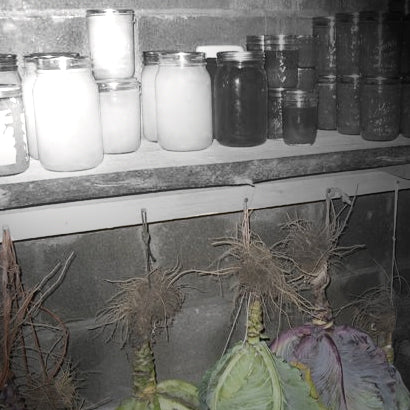
New research recently came out confirming what many of us already suspected with milk kefir grains. That cooler temperatures help grains grow and also create greater microbial diversity.
Milk kefir grains are simply happier in colder temperatures. Given the history of milk kefir, its not surprising.
Most research and references point to the kefir grains originating from North Ossetia (the northern Caucasus mountains). Temperature in those high lands rarely go above 75°f even in the heat of the summer. The grains were set out in the sun in leather bags / sacks to ferment for a day. Even with the sun, it was likely a pretty cold ferment most of the time. Our own experience is also that milk kefir does really well at low room temperatures, but really suffers when it starts to go above 80 degrees. Water kefir, ginger beer plant and kombucha have different origins and seem to do better with warmer ferments.
Details of the study
The study tested 3 temperatures (about 76, 85 and 95 F) or (24 , 30 and 35 C) By far the best temperature was the lowest one - (76°f / 24°c). The grains grew significantly better than the other two and the microorganisms were more diverse. The 85° and the 95° were similar with the 95° being only slightly worse than the 85° and slightly less diverse. So it seems that temperatures around 80° and above are simply not good for the grains.
Interesting parts of the study:
Yeast is important for growth
Yeast tends to increase slowly with temperature up to about 76°, but after that it starts to die out faster than the bacteria. It’s likely the reason why the ferments suffer so much at 85° and higher. A healthy balance of yeast is needed for a strong healthy ferment.
Lactobacillus loves the heat
Lactobacillus is one class of bacteria that is well studied with many health benefits. According the the study, it increases with higher temperature; whereas the other strains and yeasts start to die off. At 95°, the diversity is so low, that’s its basically only lactobacillus left standing. As good as lactobacillus may be for us, I would personally take a balanced diversity of microorganisms any day.
Great growth means more kefiran
Kefiran is the gooey stringy part of the grains. You know you have healthy, happy grains when its extra gooey and stringy. According to the study, lower temperatures makes more kefiran. Kefiran by itself has health benefits that's separate from the other strains and yeasts in kefir.
Bottom line
If you want healthy grains that grow and make a kefir that is diverse in microorganisms, then ferment at 76° or lower. Higher room temperature ferments will create a ferment rich in lactobacillus, but it will lack other healthy strains and yeasts. It will also slow the growth of the grains.


Comments
Margaret Kievlan
Rather than reusing kefir grains, I have been saving a cup from a previous batch to start a new one. The batch is probably not diverse since in the summer I made it in a very warm room. If it has lost diversity, can it regain diversity if it is later cultured in cooler temperatures?
December 07, 2021
Debra Paulson
I purchased dehydrated grains and have been using 1% pasteurized milk from Giant’s store brand. It consistently thickens in 24 hours. I swirl a whisk to mix it after straining the mixture. I reserve a scant 1/4 c. For the next quart and use cold milk and whisk it to mix. I keep it around 70 to 73 degrees.
November 09, 2021
Yemoos Nourishing Cultures
Hi Cynthia – Yes, raw milk tends to make a slow bacteria rich ferment no matter what you do. It can be more tricky to ferment with pasteurized milk as it can ferment faster and get more yeasty over time. High quality milk with minimal processing does help. Cooler temperature with less grains and occasional stirring helps as well.
August 10, 2021
Cynthia Munley
I used to have a wonderful kefir culture, where a large quantity of grains were produced but it did not over ferment the ferment. That was when I was using mostly raw milk. The grains I now use seem to ferment the milk way too fast with very few grains. Is it because I use pasteurized milk? I want to reconstruct the ferment I previously had with my new grains. Do I need to lower the yeast?
August 10, 2021
Genny
Hi – Thanks for all the really helpful info. I recently got some grains from a friend and re-started culturing milk kefir. I have a thriving water kefir culture, so that’s not a prob. I’m in Singapore where temperature is typically betwn 27 to as high as 33 deg C during the day. I find in fact that the milk kefir culture time is markedly shorter than 24 hour. If i leave for even 12 hour the grains seem to over-culture into curds and whey. So i watch it and harvest maybe less than 10 hours. But I struggle with making the kefir milk more creamy. The grains too seem small but I know they are active bec they grow, and fermentation does happen. Can you suggest pls what I shld do to make the milk creamier? Should I stick to culturing in fridge? Thank you
April 24, 2020
Yemoos Nourishing Cultures
Hi Louise – Great question! I’ve also heard that diversity can sometimes be bad, but I believe that’s mostly in reference to lab based probiotics. Those who combine probiotic strains, such as in probiotic pills, sadly don’t really know what they are doing. The probiotic industry is very young and the microbiome is incredibly complex, so its really hard to know how different strains that are combined really work. Kefir is different though. They are in an environment that’s already in a strong optimal balance. The natural diversity in grains works well together and it would make sense that they would work well within your digestive tract as well.
November 20, 2019
Louise Jackson
I have heard it suggested from a microbiologist that some people believe that having more diverse microorganisms may not necessarily be good, as they may actually work against one another. Is there any evidence that more is better?
November 20, 2019
Yemoos Nourishing Cultures
Hi Elisabeth – Yes, fridge fermenting will lower the overall diversity of the ferment. That doesn’t mean that its unhealthy or bad, its just not potentially as diverse as a room temperature ferment. It’s still good and there’s no reason to stop if it works so well for you.
November 18, 2019
Elisabeth
I have been fermenting mine in the fridge. It takes about 3 or 4 days and I do this as I am out so much that I can’t monitor the fermentation. Am I losing some of the goodness?
November 18, 2019
Yemoos Nourishing Cultures
Hi Leda – Milk kefir should be pleasant if done right. If you are needing to flavor it just to drink it, its probably not balanced right or its over fermenting. Try using less grains and more milk or help balance them or try new grains. Sometimes grains that were dried have trouble getting back to full health. As far as the milk, you can use milk directly out of the fridge. It’s typically the easiest and safest way (there may be more spoilage bacteria with pasteurized milk if you let it sit out too long). Warmer milk may help kick start the process a bit but the overall ferment won’t change too much.
August 01, 2019
Leave a comment